While walking up the boardwalk from Explore the Wild I noticed a large jumping spider perched in the middle of the walkway. The spider was black with bold white markings. As the spider turned to face me, I noticed green chelicerae, or jaws. If you’ve never had a close look at a jumping spider I urge you to do so, they can be quite colorful.
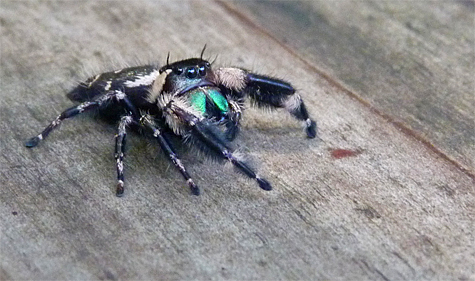
When I first saw this spider I thought that it was a Bold Jumping Spider (Phidippus audax) but it was pointed out to me by Rachael Knight (Butterfly House) that it’s actually Phidippus otiosus or Canopy Jumping Spider. The white on the side of the cephalothorax and white markings on the abdomen help to distinguish it from Bold Jumping Spider.
Of all the spiders, it seems that jumping spiders are the least offensive to humans. Most of the numerous species of jumpers are small creatures and the fact that they have short legs perhaps makes them less intimidating. I think it’s the big, long, sometimes hairy legs of some spiders that freak out most people. I myself will tolerate a jumping spider walking along the crown molding of my living room, while a wolf spider scampering across the carpet gets an immediate escort out the door.
The same day that I saw the jumper I also came across several dragonflies ovipositing in rain puddles alongside the path on the Outdoor Loop. In each case it was a Great Blue Skimmer. It seemed to me futile for the dragonflies to lay eggs in these puddles of rain water, they would surely dry up before the eggs hatched. But there they were, these largest of skimmers, dropping eggs into the puddles, and in some cases ovipositing onto mere wet pavement.
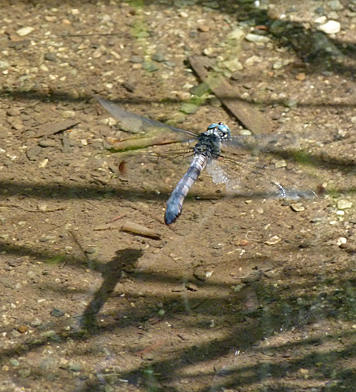
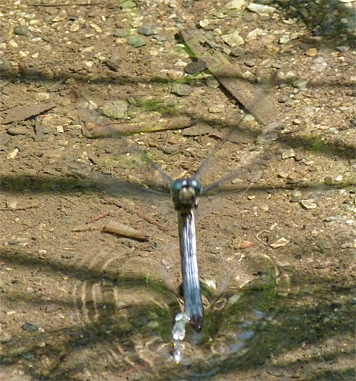
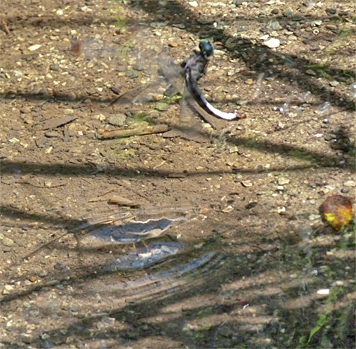
The dragonfly above was ovipositing directly in front of the Toodons. The pavement is often wet at that location.
Meanwhile, up in Catch the Wind, I saw a large caterpillar crossing the path. It was a Tersa Sphinx, and one of the hornworms that bear a spike near the tip of the abdomen. This one has eyespots along its sides with two large spots on the thoracic region much like some of the swallowtail butterflies. It uses these eyespots to intimidate potential predators.
I couldn’t resist poking at the caterpillar as it ambled along. It immediately stopped its forward motion, pulled in its head, puffed up its thorax, and coiled up like a small snake.


When I had finally satisfied my curiousity, and took a bunch of photos, I let the caterpillar be and it moved along as before, most likely searching for a safe place in the forest leaf litter in which to pupate.
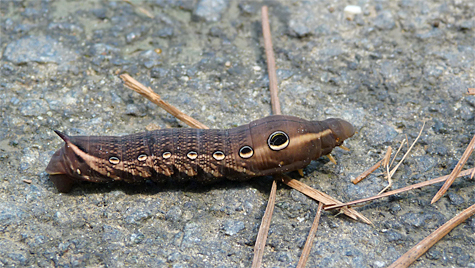
For the past few weeks I’ve been seeing pieces of pine cones strewn across the boardwalk, the work of gray squirrels.
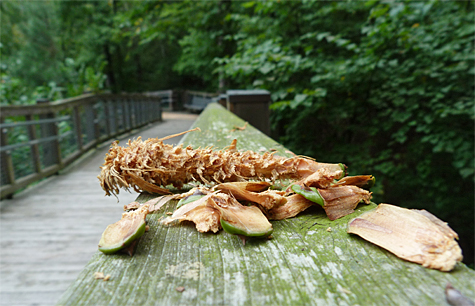
Finally, keep looking up, you never know what’s going to fly by. Just about a week ago, a Magnificent Frigatebird was spotted flying over Streets of Southpoint Mall in Durham and again later that day over Lake Jordan. Frigate Birds are essentially tropical birds although they can be seen in Florida and the Gulf States, occassionally coastal NC. It’s speculated that this particular frigate bird moved north with Hurricane/Tropical Storm Isaac.
So, what does a frigatebird have to do with the Museum? Not much really, except that it’s fall and birds are moving south so it will behoove you to look up every once in a while. Why, just the other day (9/5) I was standing on the Cafe Plaza here at the Museum when a Red-shouldered Hawk called out. I looked up, and instead of seeing a Red-shoulder, I saw an Osprey. So, look up!
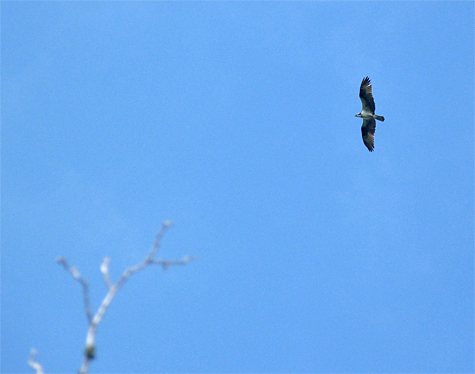
Where do you think this Osprey is going? Is it one of our local nesters (Falls Lake) or is it from farther north, perhaps New Jersey, New England, New Hampshire?

Check out Migration 2012 and see what the possibilities are for this migrating Osprey.
You have inspired me to look for things on the ground and in the air and think I found something unusual in my garden today…..a star mushroom!
A website said they are common but this is the first one I’ve ever seen and still have it.
Great, I’m glad to have inspired you!
I’ll have to keep my eyes opened for those little stars.
Thanks,